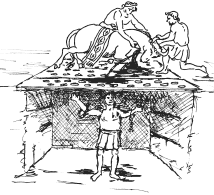
 |
Freethought & Rationalism ArchiveThe archives are read only. |
|
|||||||
|
|
Thread Tools | Search this Thread |
|
|
#1 | ||
|
Veteran Member
Join Date: Jun 2010
Location: seattle, wa
Posts: 9,337
|
I am wondering about this statement in Irenaeus which I find puzzling on a number of levels:
Quote:
Quote:

|
||
|
|
|
|
#2 |
|
Veteran Member
Join Date: Sep 2004
Location: Birmingham UK
Posts: 4,876
|
There is no doubt that Taurobolium's were performed in the rites of Cybele.
IF Irenaeus is thinking of a Taurobolium it is probably related to Cybele not Mithras. Andrew Criddle |
|
|
|
|
#3 |
|
Veteran Member
Join Date: Jun 2010
Location: seattle, wa
Posts: 9,337
|
That's quite helpful Andrew. Thanks
|
|
|
|
|
#4 |
|
Banned
Join Date: Sep 2011
Location: middle east
Posts: 829
|
Take a gander at this statue, 8000 years old, of an Phrygian masterpiece.
http://en.wikipedia.org/wiki/Cybele Umm, so, did the Mithraic tendency, (which Roger and I disagree about, he thinks it a purely Roman invention, I argue, contrarily, that it is a purely Persian invention, which the Romans adopted) borrow from this even more ancient tradition from the Phrygians? The conflict between the IndoEuropeans and the Hittites for the country we call today, Turkey, i.e. headwaters of the Tigris and Euphrates, must have been very important in ancient times. 
|
|
|
|
|
#5 |
|
Veteran Member
Join Date: Feb 2012
Location: Auburn ca
Posts: 4,269
|
As well, the problem with romans doing a bull sacrifice in mithras, is that they had their own sect that did sacrifices, and took care of he meat before the mithras feast.
the lack of a sacraficial alter semi confirms, the lack of animal sacrifice in places of their worship. While animal bones have been found in the floors through archeology |
|
|
|
|
#6 | |
|
Veteran Member
Join Date: Feb 2012
Location: Auburn ca
Posts: 4,269
|
Quote:
to what extent for different cults is so debatleable due to the lack of written information on these cults |
|
|
|
|
|
#7 | |
|
Veteran Member
Join Date: Apr 2002
Location: N/A
Posts: 4,370
|
Quote:
All the best, Roger Pearse |
|
|
|
| Thread Tools | Search this Thread |
|